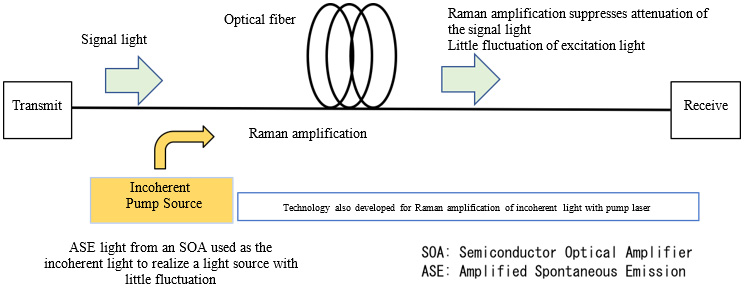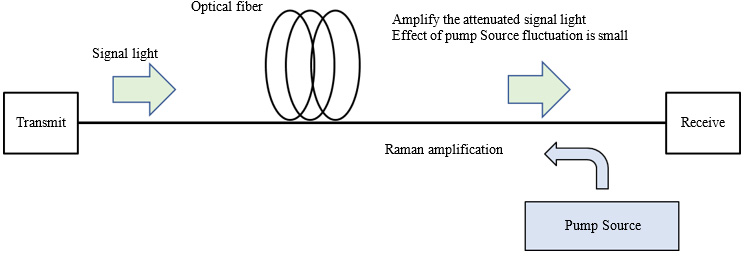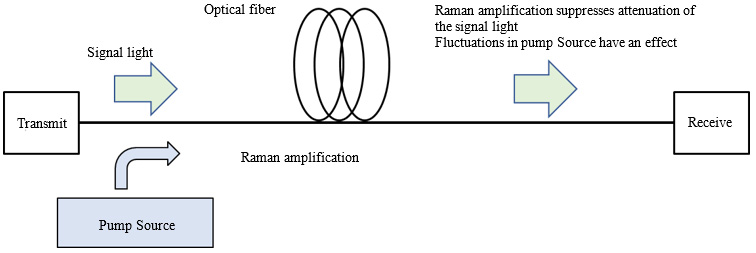Development of New Pump Source Technology for Raman Amplification
Furukawa Electric has developed new Pump Source technology for Raman amplification using incoherent light. The new Pump Source technology using incoherent light suppresses the effect of fluctuations in the pump light on the signal light. This makes it possible to realize co-propagating Raman amplification, the practical application of which has been difficult in the past. Co-propagating Raman amplification is an effective technology for the improvement of transmission characteristics and extension of transmission distance in optical fiber communications. This new development is expected to contribute greatly to the development of high-speed and large-capacity optical fiber communications systems, including for digital coherent optical transmission at 600 Gb/s and at over 1 Tb/s, which is being developed around the world in response to the expected rapid increase in traffic in the 5G era.
This new Pump Source technology and its effectiveness in Raman amplified light transmission were presented at Photonics West 2019(note 1), the world's largest international conference on optical technology held in San Francisco from February 7, 2019, and at OFC 2019(note 2), the world's largest international conference on optical fiber communication that is being held in San Diego from March 3, 2019.
Background
Together with Er-doped optical fiber amplification (EDFA), Raman amplification using optical fiber is one of the core technologies currently supporting optical fiber communications. The first practical application of EDFA was in the early 1990s. It uses 1.48 μm and 0.98 μm pump lasers. Furukawa Electric has led the world in the development of higher output 1.48 μm pump lasers and their practical application. The development of a high-power 1.48 μm pump laser promoted the development of Raman amplification technology and the practical application of the technology was achieved from the late 1990s to the early 2000s. In particular, Raman amplification using transmission optical fiber as the distributed amplification medium, is widely used in combination with EDFA, as a technology to improve transmission performance degradation due to optical fiber loss.
In Raman amplification, the fluctuation in the pump source can be transferred to the amplified optical signal, and this effect is maximum when the pump travels in the same direction as the signal (co-propagating) and minimum when the pump travels in the opposite direction (counter-propagating). Therefore counter-propagating Raman amplification, where the amplification is from the receiving side, is used as the standard method. In counter-propagating Raman amplification, the fluctuation of the pump light impressed on the signal light is averaged and the effect of it is reduced. However, there is a limit to the improvement of the transmission characteristics of the signal that has already propagated through the optical fiber. Co-propagating Raman amplification makes it possible to maximize the effect of Raman amplification, which further improves transmission characteristics. For this reason, it has long been hoped that new Pump Source technology would be developed to improve noise performance for co-propagating Raman amplification.
Details
This new Pump Source technology uses Amplified Spontaneous Emission(ASE) that is emitted by a Semiconductor Optical Amplifier(SOA) as an incoherent light source. ASE is random light that does not have the fluctuations between oscillating modes that are seen in lasers with Fabry-Perot resonator structures. Even in co-propagating Raman amplification, it has no effect on the signal light.
However, optical modules for application to optical fiber communications systems must have a small size and high reliability. Furukawa Electric has SOA and advanced packaging technology that has been cultivated in the development of signal light Source for digital coherent optical transmission. By fully utilizing these technologies, we have now succeeded in the development of compact and high-output incoherent light source technology. We also promoted the development of technology for the Raman amplification of incoherent light with a pump laser and worked to expand the scope of its application to optical fiber communications systems. Because an ASE source is broadband in nature, one practical application of this technology will be as the first-order Raman pump in second-order Raman amplifiers for long or high loss spans, to reduce the cost-per-bit of transport.
Furukawa Electric has continued to lead the world in the field of pump lasers for Raman amplification and EDFA. With this new development of Pump Source technology using incoherent light, we will continue to contribute to the development of optical fiber communications systems with larger capacities and greater sophistication.
Related research presentations
(note 1)M. Morimoto et al “Co-Propagating Distributed Raman Amplifier Utilizing Incoherent Pumping” Photonics West 2019, Invited Paper 10946-21
(note 2)T. Kobayashi et al, “PDM-16QAM WDM Transmission with 2nd-order Forward-pumped Distributed Raman Amplification Using Incoherent Pumping” the Optical Fiber Communication Conference (OFC) 2019, paper Tu3F.6
Co-propagating Raman amplification using new Pump Source technology

Reference
• Counter-propagating Raman amplification: Currently used as the standard method

• Co-propagating Raman amplification: Its realization was much anticipated because of its excellent improvement of transmission characteristics








 Share
Share Tweet
Tweet Share
Share